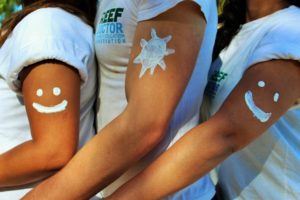Not just a drop in the ocean….
 Sunscreen is an essential part of almost everyone’s holiday preparations. We choose a sunscreen that we can afford, that offers the right level of SPF protection and that comes in a spray, cream or oil depending on our preferences. But do we look at or even care about what’s actually in our sunscreen? Is your sunscreen giving you and your environment the best protection it can? When it comes to the sea your sunscreen could be letting you down. Any diver who learned to dive with a reputable organization knows that caring for our oceans and everything that lives in them is an essential part of learning to dive and continuing to dive. New divers learn that it’s vital to protect the underwater environment for future generations to visit. But even the most careful diver could be damaging coral reefs systems without even knowing it. Corals are vulnerable to many threats created by our modern world such as over fishing, rising sea temperatures, ocean acidification and run off from industry and agriculture. But corals are also being damaged by something much less obvious. Something each and every one of us can do our part to address. Sunscreen!
Sunscreen is an essential part of almost everyone’s holiday preparations. We choose a sunscreen that we can afford, that offers the right level of SPF protection and that comes in a spray, cream or oil depending on our preferences. But do we look at or even care about what’s actually in our sunscreen? Is your sunscreen giving you and your environment the best protection it can? When it comes to the sea your sunscreen could be letting you down. Any diver who learned to dive with a reputable organization knows that caring for our oceans and everything that lives in them is an essential part of learning to dive and continuing to dive. New divers learn that it’s vital to protect the underwater environment for future generations to visit. But even the most careful diver could be damaging coral reefs systems without even knowing it. Corals are vulnerable to many threats created by our modern world such as over fishing, rising sea temperatures, ocean acidification and run off from industry and agriculture. But corals are also being damaged by something much less obvious. Something each and every one of us can do our part to address. Sunscreen!
Traditional sunscreens are loaded with preservatives, chemicals and nano particles that have now been proven to damage coral reefs by contributing significantly to coral bleaching, and cause damage to our bodies through absorption of toxins from the chemicals through our skin. The majority of these sunscreens contain oxybenzone, a chemically active ingredient that has been identified as one of the most damaging chemicals for corals. The active ingredient in sunscreen is the component that does most of all of the work to protect your skin from harmful UVA and UVB rays, which is great as long as the active ingredient is not oxybenzone or other damaging ingredients such as avobenzone, octisalate, octocrylene and octinoxate or a combination of these chemicals.
A report published in 2015 in the Archives of Environmental Contamination and Toxicology reveals that oxybenzone  is a major contributing factor in widespread coral bleaching. Furthermore the chemical does not just kill the coral. It damages DNA in adult coral and deforms DNA in coral in the larval stage making it unlikely to form properly. Sadly this means that anytime you wear a sunscreen that contains oxybenzone or other harmful active ingredients and swim in waters that contain corals you are actively allowing the damaging chemical to come in contact with fragile corals. The Washington Post (2015) notes that ‘the equivalent of a drop of water in a half dozen Olympic sized swimming pools’ is enough to damage fragile coral reef systems. Just think how much sunscreen it takes to cover every tourist that visits a beach that has coral reefs nearby! A lot, right? Well, it is estimated that 14,000 tons of sunscreen ends up in coral reefs worldwide annually (Huffington Post). 14,000 TONS!!!!
is a major contributing factor in widespread coral bleaching. Furthermore the chemical does not just kill the coral. It damages DNA in adult coral and deforms DNA in coral in the larval stage making it unlikely to form properly. Sadly this means that anytime you wear a sunscreen that contains oxybenzone or other harmful active ingredients and swim in waters that contain corals you are actively allowing the damaging chemical to come in contact with fragile corals. The Washington Post (2015) notes that ‘the equivalent of a drop of water in a half dozen Olympic sized swimming pools’ is enough to damage fragile coral reef systems. Just think how much sunscreen it takes to cover every tourist that visits a beach that has coral reefs nearby! A lot, right? Well, it is estimated that 14,000 tons of sunscreen ends up in coral reefs worldwide annually (Huffington Post). 14,000 TONS!!!!
Sunscreen does not spread or dissipate easily in water. Therefore tourist hotspots tend to have much higher concentrations of the chemical in the water. Unfortunately, a lot of tourist hotspots also have coral reef systems. It is estimated that 90% of dive and snorkeling tourism is concentrated in 10% of the world’s coral reefs (National Oceanic and Atmospheric Administration: NOAA). But you don’t have to be a diver or snorkeler to contribute to the damage. Even if you haven’t been in the sea on holiday the sunscreen you apply every day gets washed away in the shower and ends up in the wastewater system thereby ending up in the sea anyway in most cases.
This is all very compelling evidence to suggest that we all need to be far more responsible when it comes to what products we take into the water with us. However this may not be compelling enough for those of us who don’t feel a responsibility to our environment (and sadly, yes there are people who don’t). Is there any other reason to switch to a reef safe sunscreen? Well, yes. There is also evidence to suggest that the toxins in oxybenzone are absorbed through the skin every time sunscreen is applied. Based on a representative sampling of children and adults it is estimated that 96% of Americans have oxybenzone in their bodies (Centre for Disease Control, Calafat 2008). Laboratory tests have shown that oxybenzone upsets hormone levels and acts like estrogen in the system, altering sperm counts in many animals and causing endometriosis in women. It has also been found in mothers’ breast milk and been found to cause skin allergies. So whatever way you look at it and no matter what you are seeking to protect oxybenzone is bad news.
But do you have to decide between protecting your skin and protecting corals? Thankfully, no you don’t. First of all hats, long sleeve shirts and sarongs provide good shade from the sun’s harmful rays. There are also many different options now available for people who love spending time in the sea and who care about protecting our oceans. No sunscreen is completely ‘reef safe’ but the term is being used to refer to sunscreens that cause much less damage to corals than traditional sunscreens. Reef safe sunscreens are oxybenzone free and are very often free of parabens, nano particles and other nasty chemicals, of which we are increasingly becoming aware and do not want in our skincare products. Mineral active ingredients such as zinc oxide, titanium dioxide, which have not been found to harm corals, or a combination of both provide the sun protection in reef safe sunscreens.
One of the main criticisms leveled at sunscreens containing mineral active ingredient is that they are hard to apply and have a ‘paint like’ quality. However this is something that manufacturers are aware of and new more user-friendly versions are coming out all the time. Another draw back critics site is cost. Reef safe sunscreens tend to be all-natural and unfortunately they are often a little more expensive than the cheaper common chemical based sunscreens. However they are similar in price to sunscreens from some of the bigger manufacturers so this argument does not hold a lot of water. But personal experience confirms that reef safe sunscreens last a very long time and do provide excellent protection from the sun making them very good value for money. They are best applied on well moisturized skin that is dry to the touch So it might take you a little longer to rub the cream in before you hit the water but is it really worth contributing to coral reef damage just to save two minutes and a tiny bit of elbow grease?
When it comes to being responsible for our environment people often say that anything one individual can do will make no difference. Despite the fact that this logic is flawed (but that’s another article for another time) wearing reef safe sunscreen is actually something that individuals can do that can make a very big difference. In fact, everyday average people are those best placed to address this problem. By making one simple change to your holiday preparations you are not only ensuring that you and your family are protected, you are also making sure that one of the most important ecosystems in the world is being protected. It is within your capabilities. Make a difference and go reef safe today!!
Report by RD Comms Officer Ivana Rubino




